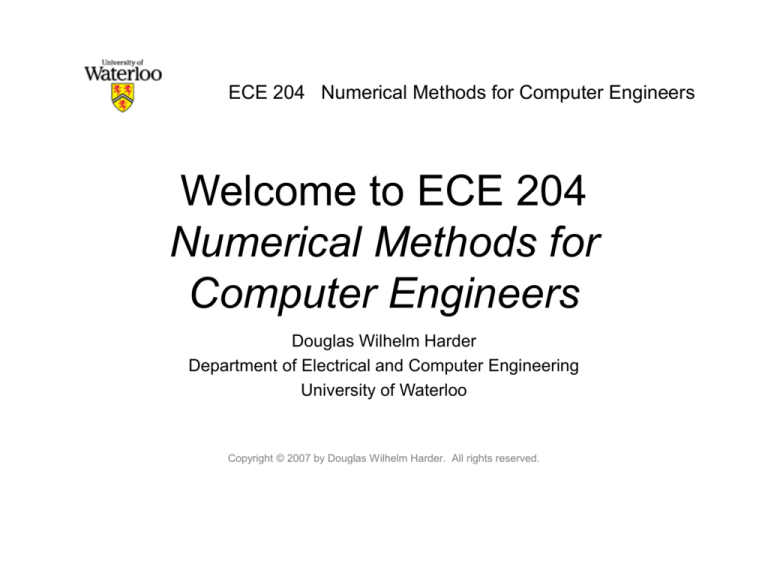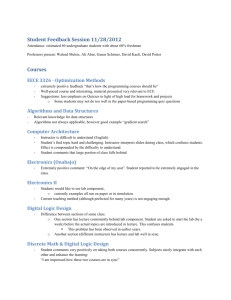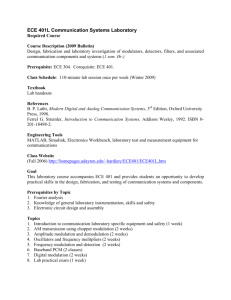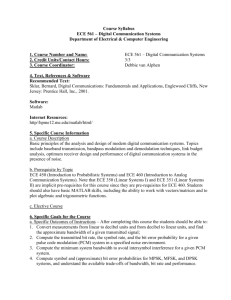
ECE 204 Numerical Methods for Computer Engineers
Welcome to ECE 204
Numerical Methods for
Computer Engineers
Douglas Wilhelm Harder
Department of Electrical and Computer Engineering
University of Waterloo
Copyright © 2007 by Douglas Wilhelm Harder. All rights reserved.
ECE 204
Numerical Methods for Electrical and Computer Engineers
Welcome to ECE 204
Numerical Methods for Engineers
Douglas Wilhelm Harder
Department of Electrical and Computer Engineering
University of Waterloo
Copyright © 2007 by Douglas Wilhelm Harder. All rights reserved.
Introduction
Everything should be made as simple as
possible, but no simpler.
Einstein (paraphrased)
Introduction
• Welcome to ECE 204
• Instructor: Douglas Wilhelm Harder
Introduction
• In ECE 150 and ECE 250, you have been
given an introduction to programming,
data structures, and algorithms
• We will now show how we can use
algorithms to solve mathematical problems
Introduction
• As an engineering, it is your job to solve
the engineering problem-at-hand in the
most efficient manner possible
• If you are less efficient than someone else,
then you will ultimately pay (monetarily, of
course...)
Introduction
• Given any engineering problem (especially
in electrical and computer engineering),
we are able to model the problem
mathematically
– more on this in ECE 342 Signals and Systems
• If we can solve the model on the
computer, then we can simulate reality
• Thus, we can actually prototype designs
on a computer without building them
Introduction
• Using the design of aircraft as an example:
– years ago, any new aircraft would begin with
a reasonably small-scale model
– this model would be tested, and then a larger
model would be built
– with the larger model, the effects of scale are
then observed and corrected
– in some cases half-scale models of aircraft
would be built before the full-scale prototypes
are made
Introduction
• As you may observe, this is an expensive
process
• To given an example of today’s
technology, the Airbus A380, the doubledecker jumbo jet, was modeled entirely in
a computer
• Only when the computer model was
perfected did they actually build the
aircraft, and the rest is history...
Introduction
• Consider some of the problems:
– with smoking banned on flights, the removal
of the ash trays resulted in an incredible fuel
savings
– if the mathematical model was wrong and the
A380 was even 1% heavier than it could have
been, this would have resulted in a
tremendous fuel inefficiency over the life of all
the aircraft
– Boeing would build a better jumbo and take
the market away...
Introduction
• Consider some of the problems:
– if the models are wrong, or if information put
into models was wrong, then we could
experience a failure...
– the extreme example is the Mars Climate
Orbiter, launched on December 11th, 1998 and
crash landed on September 23rd, 1999
because the measurements were sent in
Imperial but assumed to be in metric:
1 lbf = 4.4482216152605 N
Introduction
• As electrical and computer engineers, you
will be designing circuits
– consider having to build prototypes of each
circuit you design
– any errors could be the result of your design,
or the fault of your model
– you cannot build “scale models”
Introduction
• Alternatively, you could model your circuit
on the computer
• You will be using SPICE to model your
circuits in your other courses
– it is much less expensive to find errors in your
model when simulating them than after you
actually construct the circuit
Introduction
• Thus, we have the following diagram:
Introduction
• There are a number of possible errors:
– Modeling Error: a wrong or inappropriate
choice of model
– Measurement Error: incorrect or poor
measurements
– Implementation Error: incorrect or poor choice
of algorithms
– Simulation Error: error accumulated due to
the execution of our model
Introduction
• You will learn how to avoid modeling,
measuring, and implementation errors in
your other classes
• We will focus on the last source of errors:
numerical errors occurring during the
simulation stage
References
• The course web site:
http://www.ece.uwaterloo.ca/~ece204/
• The course text are a collection of my own
notes online
– they have been used for two years now and
have been well received by students
Matlab
• While this is not a course in teaching you
how to program, we will be using Matlab to
both demonstrate and evaluate you on
your knowledge of the course material
• At the start of many of the lectures, I will
begin with a “Matlab minute”, a short
introduction to Matlab
Evaluation
• The course evaluation is performed
through:
– midterm examination
– final examination
40%
60%
Academic Offences
• Academic Offences include, but are not
limited to:
– Infringing unreasonably on the work of other
members (e.g., disrupting classes)
– Cheating
– Plagiarism
– Misrepresentations
• All students must read Policy 71
Plagiarism
• All instances of Plagiarism are reported to
the Associate Dean of Undergraduate
Studies
Usage Notes
• These slides are made publicly available on the web for
anyone to use
• If you choose to use them, or a part thereof, for a course
at another institution, I ask only three things:
– that you inform me that you are using the slides,
– that you acknowledge my work, and
– that you alert me of any mistakes which I made or changes
which you make, and allow me the option of incorporating such
changes (with an acknowledgment) in my set of slides
Sincerely,
Douglas Wilhelm Harder, MMath
dwharder@alumni.uwaterloo.ca








